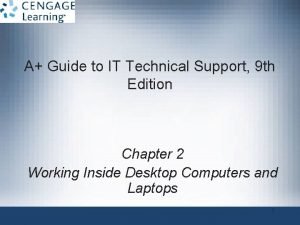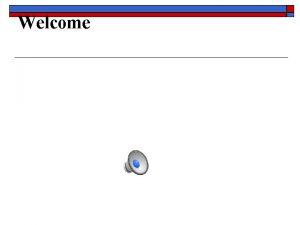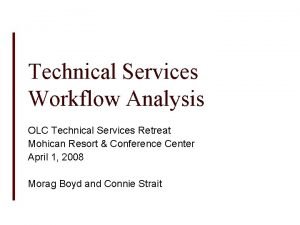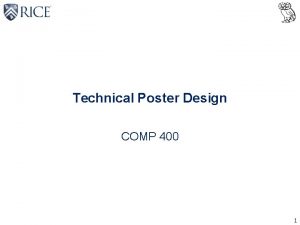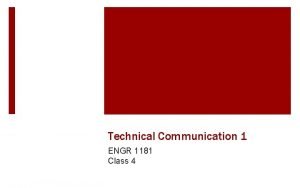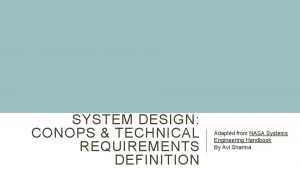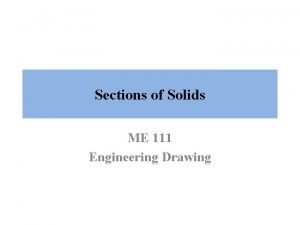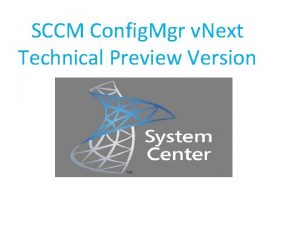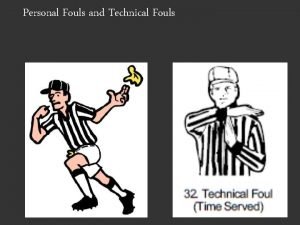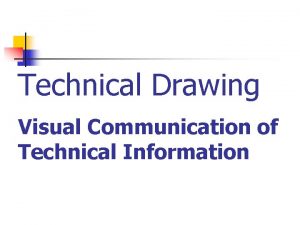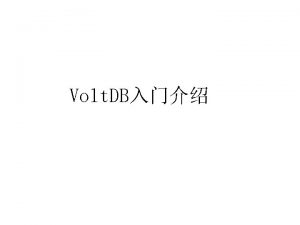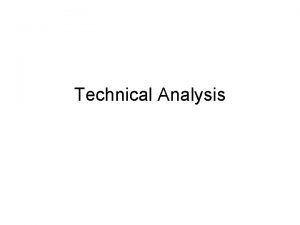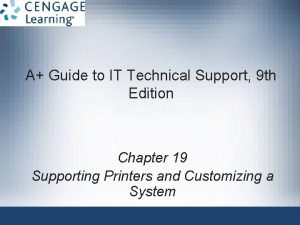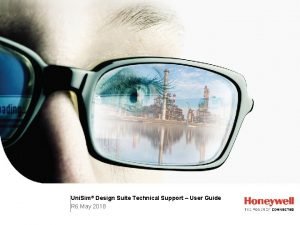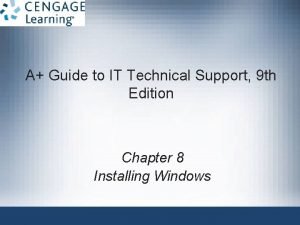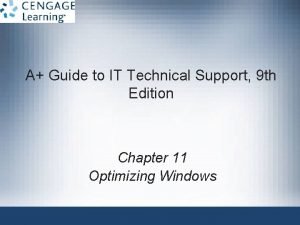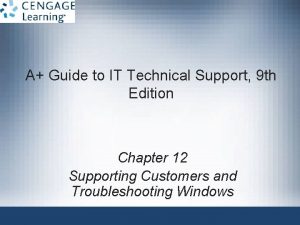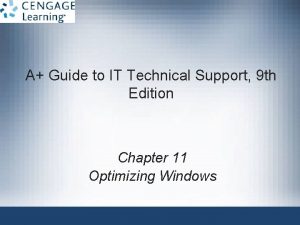A Guide to IT Technical Support 9 th


































































- Slides: 66

A+ Guide to IT Technical Support, 9 th Edition Chapter 9 Supporting I/O Devices

Objectives • Describe the general approach technicians use to install and support I/O devices • Install and configure several I/O devices, such as barcode readers, biometric devices, digital cameras, webcams, graphic tablets, and touch screens • Install and configure adapter cards • Support the video subsystem, including selecting a monitor and video card and supporting dual monitors and video memory • Troubleshoot common problems with I/O devices A+ Guide to IT Technical Support, 9 th Edition © Cengage Learning 2017 2

Basic Principles For Supporting Devices • I/O devices may be internal or external • Fundamental principles and concepts: – – – Every device is controlled by software Best guide for installation and support: manufacturer Some devices need application software A device is no faster than the port/slot it is designed for Use an administrator account in Windows Problems are sometimes solved by updating drivers or firmware – Install only one device at a time A+ Guide to IT Technical Support, 9 th Edition © Cengage Learning 2017 3

Basic Principles for Supporting Devices • Device Manager (devmgmt. msc) – Primary Windows tool for managing hardware • Using Device Manager you can: – – Disable or enable a device Update its drivers Uninstall a device Undo a driver update ( called a driver rollback) A+ Guide to IT Technical Support, 9 th Edition © Cengage Learning 2017 4

Ports and Wireless Connections Used by Peripheral Devices Table 9 -1 Data transmission speeds for various port types and wireless connections A+ Guide to IT Technical Support, 9 th Edition © Cengage Learning 2017 5

Ports and Wireless Connections Used by Peripheral Devices • USB Connections: – The USB Implementers Forum, Inc. uses the following symbols Figure 9 -1 Super. Speed, Hi-Speed, and Original USB logos appear on products certified by the USB forum A+ Guide to IT Technical Support, 9 th Edition © Cengage Learning 2017 6

Ports and Wireless Connections Used by Peripheral Devices • USB Connections (cont’d): – As many as 127 USB devices can be daisy chained together – USB uses serial transmissions and devices are hotswappable (plug and unplug without powering down) – A USB cable has four wires, two for power and two for communication A+ Guide to IT Technical Support, 9 th Edition © Cengage Learning 2017 7

Ports and Wireless Connections Used by Peripheral Devices Table 9 -2 USB connectors A+ Guide to IT Technical Support, 9 th Edition © Cengage Learning 2017 8

Ports and Wireless Connections Used by Peripheral Devices • Fire. Wire (IEEE 1394) Connections – Hardly used in new devices – Uses serial transmissions and devices are hotswappable – Fire. Wire 800 allows for up to 63 devices and Fire. Wire 400 allows for up to 16 devices to be daisy chained together – Fire. Wire 400 supports two connector types – Fire. Wire 800 uses a 9 -pin rectangular connector A+ Guide to IT Technical Support, 9 th Edition © Cengage Learning 2017 9

Ports and Wireless Connections Used by Peripheral Devices • Infrared (IR) Connections – Outdated wireless technology mostly replaced by Bluetooth – Most common use of IR is by remote controls Figure 9 -4 This remote control is an infrared device that uses an IR transceiver connected to a laptop by way of USB port A+ Guide to IT Technical Support, 9 th Edition © Cengage Learning 2017 10

Installing I/O Peripheral Devices • Simple input devices (mouse and keyboard) – Can be controlled by the UEFI/BIOS or have embedded drivers built into the OS • General procedures to install any peripheral device: – 1. Read the manufacturer’s directions – 2. Make sure the drivers are written for the proper OS – 3. Make sure the motherboard port you are using is enabled – 4. Install drivers or plug in the device – 5. Install the application software to use the device A+ Guide to IT Technical Support, 9 th Edition © Cengage Learning 2017 11

Installing I/O Peripheral Devices • Mouse or Keyboard – Plug into a USB and OS should automatically recognize it and install generic drivers • Older PS/2 ports are not hot-pluggable, so you must restart Windows after plugging into this type of port – For keyboards with special features: • Install drivers that came with the keyboard – Use Device Manager to uninstall, disable, or enable most devices • USB devices are managed through Programs and Features A+ Guide to IT Technical Support, 9 th Edition © Cengage Learning 2017 12

Installing I/O Peripheral Devices • Replacing the Keyboard and Touchpad in a Laptop – Power down and remove AC adapter and battery pack – Remove screws on bottom of laptop – Open lid • Push keyboard toward lid while pulling it up to release it from the case – Bring keyboard out of the case and forward • Expose keyboard ribbon cable • Use screwdriver to lift cable connector up and out – Replace keyboard following steps in reverse order – If touchpad is part of keyboard bezel, remove keyboard before removing the keyboard bezel A+ Guide to IT Technical Support, 9 th Edition © Cengage Learning 2017 13

Installing I/O Peripheral Devices • Barcode Readers – Scans barcodes on products • Used to maintain inventory or at point of sale (POS) – Several interface methods • Wireless connection, serial port, USB port, keyboard port Figure 9 -12 Handheld or hands-free Barcode scanner by Intermec Technologies A+ Guide to IT Technical Support, 9 th Edition © Cengage Learning 2017 14

Installing I/O Peripheral Devices • Biometric Devices - inputs a person’s biological data – Additional authentication to control access to sensitive data • Fingerprint reader types may: – Look like a mouse – Use wireless or USB connection – Be embedded on side of keyboard, flash drive or laptop • Read documentation to know if you should install drivers before plugging in device A+ Guide to IT Technical Support, 9 th Edition © Cengage Learning 2017 15

Installing I/O Peripheral Devices • Digital Cameras and Camcorders – Two ways to transfer images to PC • Connect camera to the PC using a cable • Install the memory card in the PC Figure 9 -14 This laptop has two flash memory card slots A+ Guide to IT Technical Support, 9 th Edition © Cengage Learning 2017 16

Installing I/O Peripheral Devices • Webcams – Embedded on most laptops – Can be installed using a USB port or other port – Comes with built-in microphone Figure 9 -17 This personal web camera clips to the top of your laptop and has a built-in microphone A+ Guide to IT Technical Support, 9 th Edition © Cengage Learning 2017 17

Installing I/O Peripheral Devices • Graphics Tablets (also called digitizing tablet) – Likely to connect by a USB port – Comes with stylus that works like a pencil – Install the same way as other USB devices Figure 9 -19 A graphics tablet and Stylus are used to digitize a hand drawing A+ Guide to IT Technical Support, 9 th Edition © Cengage Learning 2017 18

Installing I/O Peripheral Devices • Motion Controllers (also called motion sensor) – Provides input to the computer by sensing the motion of your fingers and hands – Commonly used with gaming consoles – May be used by graphic designers or engineers who work with 3 D images – Most connect using a USB connection – Read documentation to know if you should install drivers first or the device first A+ Guide to IT Technical Support, 9 th Edition © Cengage Learning 2017 19

Installing I/O Peripheral Devices • MIDI Devices – MIDI (Musical instrument digital interface) – set of standards used to represent music in digital form – MIDI standards are used to connect musical equipment such as musical keyboards and mixers – Most sound cards can play MIDI files – MIDI port is a 5 -pin DIN port that looks like PS/2 keyboard port (only larger) A+ Guide to IT Technical Support, 9 th Edition © Cengage Learning 2017 20

Installing I/O Peripheral Devices • MIDI Devices (cont’d) – Way to connect a musical instrument to PC • MIDI to MIDI, MIDI to USB, USB to USB, and USB to MIDI Figure 9 -22 MIDI-to-USB cable lets you connect an electronic musical instrument to your computer A+ Guide to IT Technical Support, 9 th Edition © Cengage Learning 2017 21

Installing I/O Peripheral Devices • Touch Screens – Input device that uses a monitor or LCD panel as the backdrop for input options – Some laptops and monitors for desktops have built-in touch screens – Can be installed as an add-on – For most installations, install drivers before connecting by way of a USB port – Use management software that came with the device to control and calibrate A+ Guide to IT Technical Support, 9 th Edition © Cengage Learning 2017 22

Installing I/O Peripheral Devices • KVM Switches – Keyboard, Video, and Mouse (KVM) switch allows the use of one keyboard, mouse, and monitor for multiple computers – Useful in a server room or testing lab – Does not require device drivers, just plug in cables form each computer to the device – Switch between computers by using a hot key on the keyboard, buttons on KVM switch, or a wired remote A+ Guide to IT Technical Support, 9 th Edition © Cengage Learning 2017 23

Installing and Configuring Adapter Cards • When preparing to install a adapter card: – – Verify card fits an empty expansion slot Verify device drivers for the OS are available Back up important data not already backed up Know your starting point A+ Guide to IT Technical Support, 9 th Edition © Cengage Learning 2017 24

Installing and Configuring Adapter Cards • General directions to install an adapter card – Read the documentation – If replacing an onboard port, disable port in UEFI/BIOS setup – Wear ESD strap, shut down system, unplug power cords and cables, and drain power – Locate slot and prepare for installation – Insert card into expansion slot – Anchor card to top of the slot with screws – Connect any power cords or data cables A+ Guide to IT Technical Support, 9 th Edition © Cengage Learning 2017 25

Installing and Configuring Adapter Cards • General directions to install an adapter card (cont’d) – Replace the case cover, plug in any essential peripherals – Start the system – Windows should detect a new hardware device and attempt to automatically install the drivers – If a CD came with device, insert and run the setup program – May have to restart the system • If any problems with installation, turn to Device Manager to troubleshoot A+ Guide to IT Technical Support, 9 th Edition © Cengage Learning 2017 26

Installing and Configuring Adapter Cards • Sound Cards and Onboard Sound – Can play and record sound and save it in a file – Speaker ports are color-coded Figure 9 -30 Sound Blaster X-Fi Titanium sound card by Creative uses a PCIe x 1 slot A+ Guide to IT Technical Support, 9 th Edition © Cengage Learning 2017 27

Installing and Configuring Adapter Cards • TV Tuner and Video Capture Cards – TV tuner card can turn a computer into a television – Video capture card enables capturing video input and saving it to a file – Some cards are a combination of the two cards above – When installing you will most likely: • Install the drivers, install the card, and then install the application software that comes bundled with card A+ Guide to IT Technical Support, 9 th Edition © Cengage Learning 2017 28

Installing and Configuring Adapter Cards • Replacing Expansion Cards in a Laptop – Newer notebook use Mini PCI Express slots (Mini PCIe) • Uses 52 pins on the edge connector – Older notebooks use a Mini PCI slot – For many laptops, remove a cover on the bottom of the laptop to expose expansion cards • For cards that have antenna, be sure to remove the antenna wires before replacing card – Use Device Manager to ensure the device is working properly after install A+ Guide to IT Technical Support, 9 th Edition © Cengage Learning 2017 29

Supporting the Video Subsystem • Monitor: primary output device of a computer • Two necessary components for video output: – Monitor – Video card (also called video adapter or graphics card) or video port on motherboard A+ Guide to IT Technical Support, 9 th Edition © Cengage Learning 2017 30

Monitor Technologies and Features • Types of monitors – LCD (liquid crystal display) - also called flat panel • First used in laptops • At the center of layers is liquid crystal material • Layers are sandwiched between two grids of electrodes forming columns and rows • Each intersection of row and column forms a pixel • Two classes of LCD monitors: – Twisted Nematic (TN) – In-Plane Switching (IPS) A+ Guide to IT Technical Support, 9 th Edition © Cengage Learning 2017 31

Monitor Technologies and Features • Types of monitors – LCD (cont’d) • LCD panel does not produce any light, so it needs a source of light, called backlighting • Two common types of backlighting: – Cold Cathode Fluorescent Lamp (CCFL) – older technology first used in laptop monitors – LED (Light-Emitting Diode) – receives its DC power directly from the motherboard and doesn’t use an inverter A+ Guide to IT Technical Support, 9 th Edition © Cengage Learning 2017 32

Monitor Technologies and Features Figure 9 -39 Layers of an LCD panel A+ Guide to IT Technical Support, 9 th Edition © Cengage Learning 2017 33

Monitor Technologies and Features • Types of monitors (cont’d) – Plasma monitor – provides high contrast with better color than LCD monitors • Expensive and heavy – Projector – used to shine a light that projects a transparent image onto a large screen – OLED (organic light-emitting Diode) monitor uses a thin LED layer or film between two grids of electrodes • Does not use backlighting A+ Guide to IT Technical Support, 9 th Edition © Cengage Learning 2017 34

Monitor Technologies and Features Table 9 -3 Important features of a monitor A+ Guide to IT Technical Support, 9 th Edition © Cengage Learning 2017 35

Video Cards and Connectors • Video cards – Graphic adapters, graphics cards, display cards – Most motherboards have integrated video controller – Can use PCI or PCI Express motherboard slot • Ports provided by video cards – VGA: red, green, blue video using VGA port (DB-15) – DVI (Digital Visual Interface) - variations of DVI: • DVI-D – only transmits digital data • DVI-I – supports analog and digital signals • DVI-A – only transmits analog data A+ Guide to IT Technical Support, 9 th Edition © Cengage Learning 2017 36

Video Cards and Connectors • Ports provided by video cards (cont’d): – Composite video: also called RGB port • Red, green, and blue are mixed together in the same signal and uses a round RCA connector • Does not produce as sharp an image as VGA or SVideo – S-Video (Super-Video): used by some TVs and video equipment • Connector is called a Mini. Din-6 and looks like PS/2 – Component video: has been split into different components and carried as separate signals A+ Guide to IT Technical Support, 9 th Edition © Cengage Learning 2017 37

Video Cards and Connectors • Ports provided by video cards (cont’d): – Display Port: designed to replace DVI • Can transmit digital and audio data • Uses data packet transmissions similar to Ethernet, USB, and PCI Express • Expected to replace VGA, DVI, and HDMI on desktop and laptop computers – HDMI: transmits both digital video and audio • Allows for several types of HDMI connectors (best known is Type A 19 -pin) • Only works on DVI-D ports (does not transmit analog) A+ Guide to IT Technical Support, 9 th Edition © Cengage Learning 2017 38

Video Cards and Connectors Figure 9 -51 Display. Port to Mini Display. Port cable A+ Guide to IT Technical Support, 9 th Edition Figure 9 -52 HDMI to mini. HDMI cable © Cengage Learning 2017 39

Video Cards and Connectors • Digital Rights Management (DRM) – Meant to protect digital content and prevent piracy – Involves both software and hardware – HDMI and DVI allow for protected content to stay encrypted until it is on the presentation device – Also limits quality of content based on its authorization A+ Guide to IT Technical Support, 9 th Edition © Cengage Learning 2017 40

Changing Monitor Settings • Monitor buttons – Can adjust horizontal and vertical position of the screen – Can change the brightness and contrast settings – On laptops, function keys are usually used instead of buttons • Windows utilities can also be used to change monitor settings A+ Guide to IT Technical Support, 9 th Edition © Cengage Learning 2017 41

Video Memory and Windows • Graphics processing unit (GPU) – also called visual processing unit (VPU) – Uses graphics RAM installed on the card • Most video cards use: – DDR 2, DDR 3, Graphics DDR 3 (GDDR 3), GDDR 4, GDDR 5 memory • Some video cards have as much as 2 GB of graphics memory A+ Guide to IT Technical Support, 9 th Edition © Cengage Learning 2017 42

Video Memory and Windows • Windows 7/Vista Aero requirements – 128 MB video memory, Direct. X 9 or higher, Windows Display Driver Model (WDDM) • Direct. X – developmental tool developers can use to write multimedia applications – Direct. X diagnostics program: dxdiag. exe • Displays information about hardware • Helps diagnose problems with Direct. X • Graphics memory can be embedded on video card, system memory, or a combination of both – Use Advanced settings on the Screen Resolution window to see available video memory A+ Guide to IT Technical Support, 9 th Edition © Cengage Learning 2017 43

Troubleshooting I/O Devices • When troubleshooting peripheral devices: – Always try the least invasive and least expensive solutions first • This section covers how to handle some of the errors or problems you might encounter A+ Guide to IT Technical Support, 9 th Edition © Cengage Learning 2017 44

Num. Lock Indicator Light • When users complain that they cannot sign in to Windows even when entering the correct password: – Have them make sure the Num. Lock key is set correctly – Laptops use this key to toggle between the keys interpreted as letters and numbers – Most laptops have a Num. Lock indicator light near the keyboard A+ Guide to IT Technical Support, 9 th Edition © Cengage Learning 2017 45

Device Manager • Device Manager is usually a good place to start troubleshooting • To see a device’s properties, right-click the device and click Properties • Try updating the drivers – Click Update Driver on the General tab or Driver tab – If driver update creates a problem, roll back the driver update if the previous drivers were working • Try to uninstall the device and reinstall it – Click Uninstall on the Driver tab A+ Guide to IT Technical Support, 9 th Edition © Cengage Learning 2017 46

Device Manager • Updating Port or Slot Drivers on a Laptop – If you have a problem with a port or slot on a laptop, use Device Manager to see if errors are reported • Also you can update drivers for the port or slot – Manufacturers often store backups of the drivers on the hard drive under support tools • And on the recovery media, if available – Download the latest drivers from the manufacturer’s website – Still not solved, use Device Manager to uninstall the port or slot drivers and use support tools to reinstall A+ Guide to IT Technical Support, 9 th Edition © Cengage Learning 2017 47

Troubleshooting Monitors and Video • For monitor and video problems: – Try easy things first such as: • Check cable connections • Check contrast/brightness adjustments A+ Guide to IT Technical Support, 9 th Edition © Cengage Learning 2017 48

Troubleshooting Monitors and Video • Problems with Video Card Installations – When you install a video card, here is a list of things that can go wrong: • When you first power up the system, you hear a whining sound – Caused by card not getting enough power (power supply might be inadequate • When you first start the system, you see nothing but a black screen – Most likely caused by the onboard video port not being disabled in UEFI/BIOS setup (disable the port) A+ Guide to IT Technical Support, 9 th Edition © Cengage Learning 2017 49

Troubleshooting Monitors and Video • Problems with Video Card Installations (cont’d) – When you install a video card, here is a list of things that can go wrong: • When you first start up the system, you hear a series of beeps – UEFI/BIOS cannot detect video card (try reseating) • Error messages about video appear when Windows starts – May be a conflict with onboard video port (disable port) • Games crash or lock up – Try updating the drivers for the motherboard, video card, and the sound card A+ Guide to IT Technical Support, 9 th Edition © Cengage Learning 2017 50

Troubleshooting Monitors and Video • Monitor Indicator Light is Not On; No Image onscreen – Ask these questions and try: • Is the monitor power cable plugged in? • Is the monitor turned on? • Is the monitor cable plugged into the video port at the back of the PC? • Try a different monitor and a different monitor cable A+ Guide to IT Technical Support, 9 th Edition © Cengage Learning 2017 51

Troubleshooting Monitors and Video • Monitor Indicator Light is On; No Image on-screen – Try the following: • Ensure video cable is securely connected • If monitor displays POST but goes blank when Windows starts to load: – Problem is with Windows, not monitor • • • Ensure monitor is set to correct voltage (110 vs. 220) Might be problem with video card Verify video cable connection inside case Check the contrast adjustment Check brightness or backlight adjustment A+ Guide to IT Technical Support, 9 th Edition © Cengage Learning 2017 52

Troubleshooting Monitors and Video • Monitor Indicator Light is On; No Image on-screen – Try the following (cont’d): • Switch out monitor-to-computer cable • Test a monitor you know is good on the computer you suspect is bad • Check for loose socketed chips on the card • Trade a good video for suspected bad video card • Test the RAM on the motherboard • Try using a backup PCI video card if using a PCIExpress card • Trade the motherboard for one you know is good A+ Guide to IT Technical Support, 9 th Edition © Cengage Learning 2017 53

Troubleshooting Monitors and Video • Screen Goes Blank 30 Seconds or One Minute after the Keyboard is Left Untouched – If keyboard is a Green motherboard and is being used with an Energy Saver monitor • Monitor can be configured to go into standby or sleep mode after a period of inactivity • This feature can also help prevent burn-in (a permanent impression of an image is left on monitor) – Use the Power Options applet in Control Panel to configure the sleep settings on a computer A+ Guide to IT Technical Support, 9 th Edition © Cengage Learning 2017 54

Troubleshooting Monitors and Video • Poor Display – Solve these problems by using controls on the monitor and Windows settings - Do the following: • LCD monitor controls – usually located on front of monitor • Windows display settings – use to adjust font size, screen resolution, brightness, color, and Clear Type text • Update video drivers • Dead pixels – pixels that are not working A+ Guide to IT Technical Support, 9 th Edition © Cengage Learning 2017 55

Troubleshooting Monitors and Video • Poor Display (cont’d) – Solve these problems by using controls on the monitor and Windows settings - Do the following: • Dim image – laptops dim the LCD screen when the computer is running on battery – Brighten the screen using the Windows display settings • Artifacts – horizontally torn images on-screen – Try updating video drivers – Overclocking can cause artifacts – Poor display might be caused by inadequate video RAM A+ Guide to IT Technical Support, 9 th Edition © Cengage Learning 2017 56

Video System in a Laptop • If LCD panel shows a black screen but power light is on: – Look for an LCD cutoff switch or button on laptop – Try to use the video port on the laptop to connect to an external monitor – If external monitor does work, problem is with the LCD panel assembly • Will need to replace inverter or LCD panel A+ Guide to IT Technical Support, 9 th Edition © Cengage Learning 2017 57

Video System in a Laptop • Cannot Connect to External Monitor – Try the following solutions: • Make sure the monitor is getting power • Use the Function keys to toggle between the laptop display and the external monitor • Try using a different cable • Try using a different connection if the laptop and monitor have another option available A+ Guide to IT Technical Support, 9 th Edition © Cengage Learning 2017 58

Video System in a Laptop • Touch Screen is Non-responsive – Try the following solutions: • Wash and thoroughly dry hands • If there is a case or screen protector, remove it • Clean the screen with an electronic wipe or soft, lintfree cloth • Restart the device • If a third party app was recently installed, try uninstalling the app • Recalibrate the touch screen A+ Guide to IT Technical Support, 9 th Edition © Cengage Learning 2017 59

Video System in a Laptop • Flickering, Dim, or Otherwise Poor Video – Tips to solve problems with bad video: • • Verify Windows display settings Adjust the brightness Update the video drivers A flickering screen can be caused by bad video drivers, a low refresh rate, a bad inverter, or loose connections inside the laptop A+ Guide to IT Technical Support, 9 th Edition © Cengage Learning 2017 60

Video System in a Laptop • Replacing the LCD Panel in a Laptop – If LCD display entirely black: replace LCD assembly – If LCD display dim: video inverter problem – High-end laptops contain video card • May need to replace it too – General directions to replace an LCD panel: • Remove AC adapter and battery pack • Remove the keyboard • Remove screws holding hinge in place – Remove hinge cover A+ Guide to IT Technical Support, 9 th Edition © Cengage Learning 2017 61

Video System in a Laptop • Replacing the LCD Panel in a Laptop – General directions to replace an LCD panel (cont’d): • • • Remove screws holding LCD panel to the laptop Remove LCD panel from the laptop Remove screws holding the top cover and LCD panel Disconnect old inverter and install the new one Reattach LCD panel assembly to the laptop A+ Guide to IT Technical Support, 9 th Edition © Cengage Learning 2017 62

Speakers in a Laptop • Laptops and other mobile devices have built-in speakers • If not getting any sound from speakers, try: – Make sure the volume is turned up – Update the audio output drivers – Run the Playing Audio troubleshooting tool • Open Control Panel in classic view and select Troubleshooting • In Hardware and Sound group, select Troubleshoot audio playback A+ Guide to IT Technical Support, 9 th Edition © Cengage Learning 2017 63

Summary • Adding new devices to a computer require installing hardware and software • Use Device Manager to manage and troubleshoot hardware • Popular I/O ports on a motherboard include e. SATA, Fire. Wire, and USB • Wireless connections can use Wi-Fi 802. 11 a/b/g/n, Bluetooth, and Infrared standards • USB connectors include A-Male, B-Male, Mini-B, Micro-A, USB 3. 0 B-Male, USB 3. 0 Micro-B A+ Guide to IT Technical Support, 9 th Edition © Cengage Learning 2017 64

Summary • When installing devices, use 32 -bit drivers for a 32 bit OS and 64 -bit drivers for a 64 -bit OS • Biometric input devices collect biological data in order to authenticate access to a system • Generally, Windows detects new adapter cards and installs appropriate drivers • Types of monitors include LCD, plasma, projector, and OLED monitor • Video ports might be VGA, DVI-I, DVI-D, DVI-A, composite video, S-Video, component video, Display. Port, HDMI, and HDMI mini ports A+ Guide to IT Technical Support, 9 th Edition © Cengage Learning 2017 65

Summary • Use Device Manager to update drivers on I/O devices giving trouble • Video problems can be caused by the monitor, video cable, video card, onboard video, video drivers, or Windows display settings • A few dead pixels on an LCD monitor screen are considered acceptable by the manufacturer • Artifacts on the monitor screen can be caused by hardware, software, overheating, or overclocking A+ Guide to IT Technical Support, 9 th Edition © Cengage Learning 2017 66
 A guide to it technical support
A guide to it technical support Inside laptop
Inside laptop Ibm technical support number
Ibm technical support number Cisco ios upgrade planner tool
Cisco ios upgrade planner tool Multilingual technical support
Multilingual technical support Technical services support cloud computing
Technical services support cloud computing Galaxy technical support
Galaxy technical support Apprenticeship technical funding guide
Apprenticeship technical funding guide Field office technical guide
Field office technical guide Fotg
Fotg Example of major point
Example of major point Ytu erasmus
Ytu erasmus Solihull sixth form tyber
Solihull sixth form tyber Whims stand for
Whims stand for Technical bulletins whmis
Technical bulletins whmis Example of technical communication
Example of technical communication Aiba scoring system
Aiba scoring system A vocational school can also be called
A vocational school can also be called Computer system documentation
Computer system documentation Full liquid diet definition
Full liquid diet definition Technical performance measures
Technical performance measures Technical report writing quiz
Technical report writing quiz Technical diction examples
Technical diction examples Regional technical forum
Regional technical forum Skilled technical asvab
Skilled technical asvab What is tech voc
What is tech voc Technical writing vocabulary
Technical writing vocabulary What are the characteristics of technical writing
What are the characteristics of technical writing Example of technical writing
Example of technical writing What is technical writing
What is technical writing Examples of technical definition
Examples of technical definition Technical training definition
Technical training definition Olc technical services retreat
Olc technical services retreat Technical scope of work template
Technical scope of work template Technical poster design
Technical poster design Technical performance measures
Technical performance measures Means technical language.
Means technical language. Technical guidelines for disposal to land
Technical guidelines for disposal to land Spoon technical drawing
Spoon technical drawing Technical description
Technical description Style of technical communication
Style of technical communication Technical communication style
Technical communication style Technical communication
Technical communication Technical capacity example
Technical capacity example Technical bid evaluation
Technical bid evaluation Tcs technical hierarchy
Tcs technical hierarchy Peraturan technical meeting
Peraturan technical meeting Technical requirements definition
Technical requirements definition An/pyq-10(c)
An/pyq-10(c) Features of technical communication
Features of technical communication How to draw true shape of section
How to draw true shape of section Technological design and scientific investigation
Technological design and scientific investigation Sccm technical preview
Sccm technical preview Contoh rundown technical meeting
Contoh rundown technical meeting Camera techniques is technical codes
Camera techniques is technical codes Rajamangala university of technology thanyaburi (rmutt)
Rajamangala university of technology thanyaburi (rmutt) Sensory qualities in art
Sensory qualities in art Technical decisions in project charter
Technical decisions in project charter Mrts formula
Mrts formula Marginal rate of technical substitution formula
Marginal rate of technical substitution formula Personal foul vs technical foul
Personal foul vs technical foul Abc format technical writing
Abc format technical writing National technical honor society graduation cords
National technical honor society graduation cords Glatthorn naturalistic model of curriculum
Glatthorn naturalistic model of curriculum Minimalism in technical writing
Minimalism in technical writing Max technical training
Max technical training Isocost
Isocost

